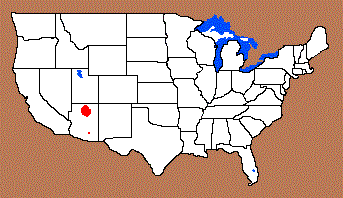Name Details:
Named By: Noel Justice
Named For: Type Site
Date Identified: 2002
Type Site: Ridge Ruin, Coconino County, Arizona
Ridge Ruin Side Notch
Cluster: Pueblo Side Notch Cluster
Commonly Utilized Material:
Chalcedony, chert and , obsidian
Date:
Cultural Period:
850 - 700 B.P.
Late Prehistoric / Developmental
Medieval Warm
Glacial Period:
Culture:
Outline is Representative of Size and Shape:
Description of Physical Characteristics and Flaking Pattern:
This is a small thin
triangular side notch point with a flattened to elliptical cross section. The blade may vary from straight to slightly excurvate. Small narrow notches angle downward, entering high on the blade and may vary from entering at a horizontal axis at or below the midpoint of the blade. The
shoulders are horizontal with and expanded stem. This point has a large basal area with many examples have parallel edges on the basal region. The basal ears may range from sharp to being slightly rounded. The base may vary from slightly concave to concave. This point has a random flaking pattern.
Size Measurement: Total Length - 25 to 56 mm, Stem Length -
13 to 15 mm, Neck Width - 4 to 8
mm, Max Width (basal width) - 13 to 21 mm, Thickness - 2
to 4 mm
Distribution:
Distribution Comments:
This point is primarily found in the Ridge Ruin region of Coconino County Arizona. Justice (2002) noted that a single example was found at Second Canyon Ruin (small red
dot). Distribution may extend to this area.

Additional Comments:
This type is similar to the Walnut Canyon type. The key difference between the two types is that the Walnut Canyon has a deeply concave or V shaped base while the Ridge Ruin type has
a straight to concave base, but not as deeply concave as the Walnut Canyon type. Notches on the Walnut Canyon type are parallel while notches on the Ridge Ruin type typically angle downward.
See link below for examples:
Pictures:

Point Validity: Valid Type
Justice is a distinguished anthropologist and Assistant Director and Curator of Collections at Glenn A. Black Laboratory of Archaeology at Indiana University. This point was named in his book on points of the Southwest. There are professional references to this type. This is considered a valid type.
.
Age Details:
Pictures Provided By:
As Illustrated by Justice (2002)
References: (See Reference Page, Entry Number):
39
Ridge Ruin Projectile Point, Ridge Ruin Arrowhead



